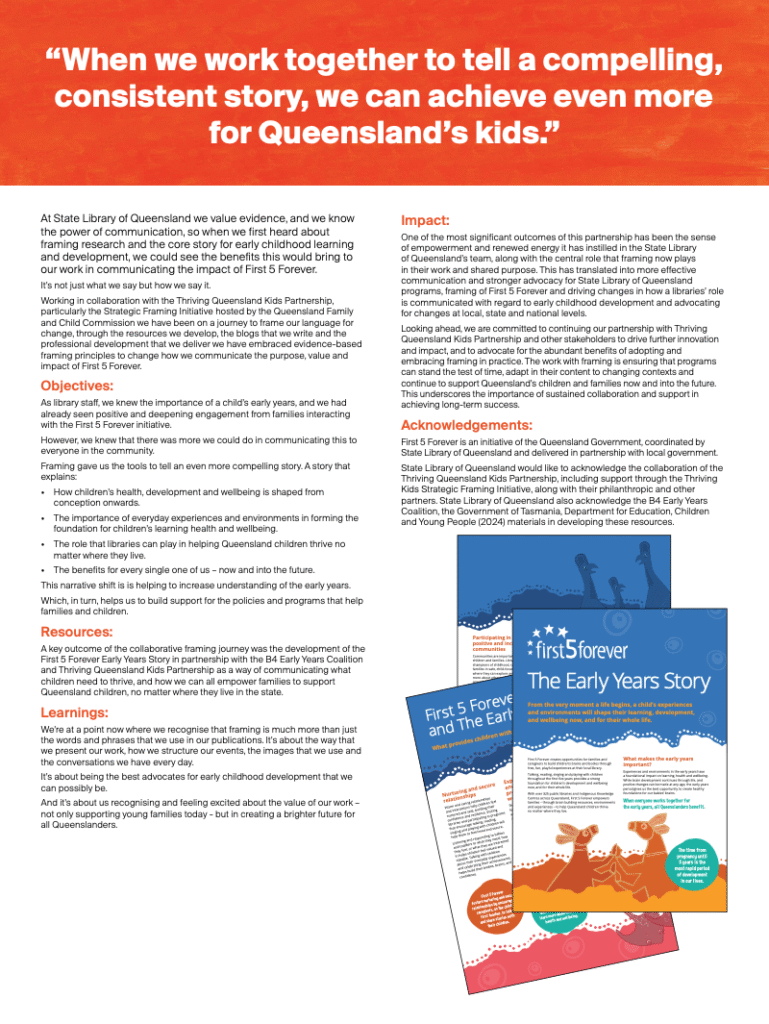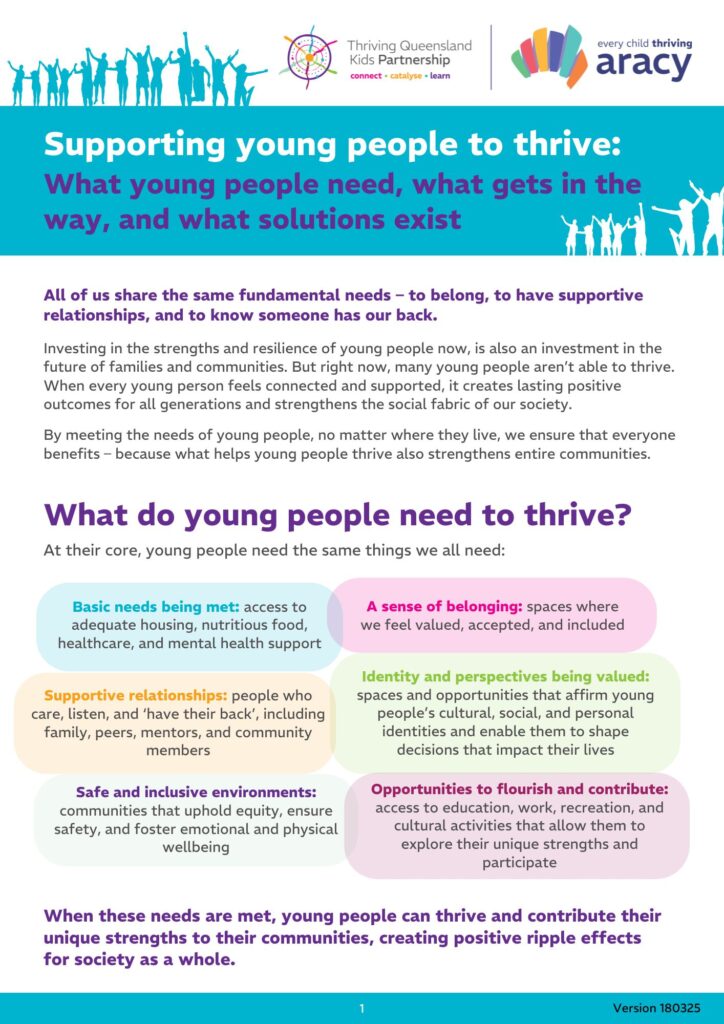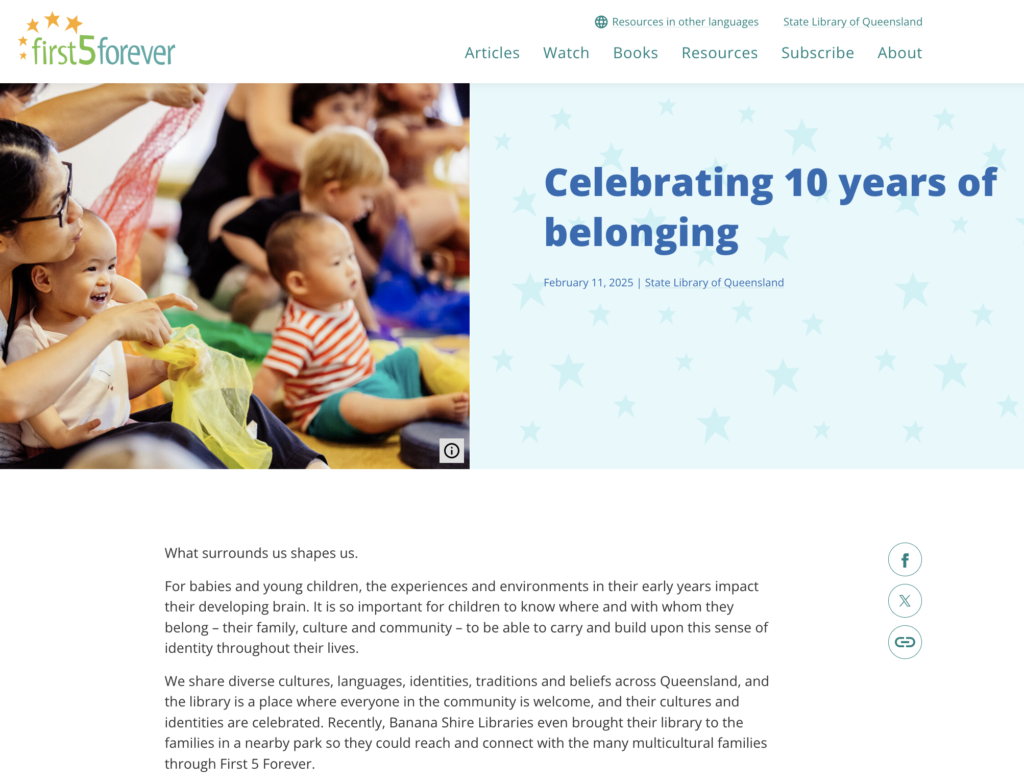What We Do / Framing for Change – Learning Hub
Section 7: Examples & Case Studies
This section includes examples of how organisations across Australia are adopting framing recommendations in their work with children and families.
From Framing Champions
As part of the Thriving Queensland Kids Partnership Framing Initiative, we have established a Framing Champions group of 22 key executive leaders from 12 organisations in Queensland. The group is working together to build a shared language as they advocate for children and young people. They are adapting their messaging for children and young people and encouraging others to adopt framing principles.
They’ve also worked together to develop framed messages that we can all use in our work to build support for policies that support families and children, including:
From ACCC – Product Safety Australia
The ACCC – Product Safety Australia Sleep Bub Safe resources have been developed in collaboration with Aboriginal and Torres Strait Islander and child health and safety advocates, including UniSC’s Professor Jeanine Young, to promote important sleep messages.
These resources ‘reframe’ safe sleep messaging to promote airway protection, which all babies need (avoiding ‘othering’ of higher risk groups), and which incorporates the rationale underpinning safe sleep messages (understanding promotes uptake). Easy to breathe, safe to sleep is a simple take home ‘gist’ message which families are more likely to remember than list-based messages. Reframing from death to breath, problem to solution, avoiding risk to pursuing protection, informing (message only) to enabling (message plus understanding) has been demonstrated to increase uptake of messaging (in Pēpi-Pod® Program evaluations) and focusses on what parents and caregivers ‘can do’ for their baby, rather than fear of what may or may not happen or which may be out of their control.

From Children's Health Queensland
Children’s Health Queensland have adopted framing into their work, including in the following programs.
Connecting2u sends evidence-based weekly texts about keeping baby safe, happy, and healthy. The messages use framing evidence to help ensure that parents feel supported and engaged. A carer will receive more messages in the first year, when most parents are learning how to care for their new baby, and will then get weekly messages until their child turns 5. This consistent messaging project is evidence-based and has specific message pathways, for example, dad-specific.
Read and Talk to Learn (RATTL) gives simple ideas to build children’s early language and literacy skills. It shows how families can use everyday situations to develop speech and language. This helps children now and into the future.


From Thriving Queensland Kids Partnership
Thriving Queensland Kids Partnership continually follows and implements the latest framing research into our work. In particular, The Core Story for Early Learning and Development informs our work every day and reminds us to weave key messages into our work around: Health and wellbeing, Now and in the future, Defining the problem, Call for fairness, What children need. Below is an example of how we have reframed a key message.

From Department of Education
The Department of Education Queensland used framing evidence to co-develop Queensland’s Early Childhood Development Story – an evidence-based ‘story’ of how children grow well.
Resources include a children’s book as well as an animation, with the aim of creating a consistent message and language about what gives children the best start in life.
From Emerging Minds
Emerging Minds has embraced framing. The Emerging Minds: National Workforce Centre for Child Mental Health (NWC) commissioned research from the FrameWorks Institute about child mental health. The related toolkit supports child mental health experts and organisations who communicate about children’s mental health to create messages that resonate and inspire positive change. Emerging Minds has integrated the research into their work and promoted the framing recommendations widely.

From NAPCAN
The National Association for Prevention of Child Abuse and Neglect (NAPCAN) follows the framing research and embeds the evidence in their work. This has included using the framing in National Child Protection Week messaging, as well as developing a Reframing Parenting Workshop to support practitioners to use the framing in their work with children and families. NAPCAN has also conducted framing research on how to talk about prevention.
From Office of Youth
This paper was created by the Thriving Queensland Kids Partnership Framing Initiative’s Framing Champions group, with the case study provided by Office for Youth. Serenity has provided informed consent for her story to be used by the Queensland Government Office for Youth in partnership with Thriving Queensland Kids Partnership for the purpose of highlighting the needs of young people and informing discussions on targeted prevention and early intervention. Click on the image to download the full document.
From Parenting Research Centre
As an early adopter of framing research in Australia, the Parenting Research Centre (PRC) has embedded framing in their work.
Raisingchildren.net.au, the Australian parenting website, provides free, reliable, up-to-date and independent information to help families grow and thrive together. An example of a re-framed statement is: ‘Warm and loving relationships that include regular positive attention help to lay the foundation for all areas of child and teenage development, including behaviour. That’s because children and teenagers do best when they feel supported, encouraged, and safe.’
The Parenting Research Centre has provided two case studies of how they have used framing evidence.
Parenting Research Centre case study: Implementing Reframing Parenting
Raising Children Network case study: Use of frames and framing guidance for RCN content

From Queensland Family & Child Commission
The Queensland Family and Child Commission is a lead partner in the Thriving Queensland Kids Framing Initiative, and has embedded framing in their work.
An example is their guide on Framing Play, which was developed to help stakeholders apply powerful insights to their communications, so they are even more effective. It is based on rigorous research about ways to communicate early childhood development and learning using a strategic framing approach.


From State Library of Queensland - First 5 Forever
The State Library of Queensland has embraced the framing research and the ARACY wellbeing domains in their First 5 Forever campaign.
Talk, Read, Sing, Play : While brain development continues through life, from birth to 5 years is the most rapid period of growth for a child’s brain, with over a million new connections forming every second. The everyday moments you spend with your child, talking, reading, singing and playing can help build a healthy brain and a healthy body, now and for their future.
Print-ready resources are available here to support you to share the First 5 Forever Early Years Story in your library or community.

Another great example of the State Library’s framing is the way they’ve used the ‘what surrounds us shapes us’ message in their First 5 Forever 10-year celebrations.
From State Library of Queensland - Case Study
At State Library of Queensland we value evidence, and we know the power of communication, so when we first heard about framing research and the Core Story for Early Childhood Learning and Development, we could see the benefits this would bring to our work in communicating the impact of First 5 Forever.
It’s not just what we say but how we say it.
Working in collaboration with the Thriving Queensland Kids Partnership, particularly the Strategic Framing Initiative hosted by the Queensland Family and Child Commission, we have been on a journey to frame our language for change. Through the resources we develop, the blogs that we write and the professional development that we deliver we have embraced evidence-based framing principles to change how we communicate the purpose, value and impact of First 5 Forever.
Objectives:
As library staff, we knew the importance of a child’s early years, and we had already seen positive and deepening engagement from families interacting with the First 5 Forever initiative.
However, we knew that there was more we could do in communicating this to everyone in the community.
Framing gave us the tools to tell an even more compelling story. A story that explains:
How children’s health, development and wellbeing is shaped from conception onwards.
The importance of everyday experiences and environments in forming the foundation for children’s learning health and wellbeing.
The role that libraries can play in helping Queensland children thrive no matter where they live.
The benefits for every single one of us – now and into the future.
This narrative shift is is helping to increase understanding of the early years.
Which, in turn, helps us to build support for the policies and programs that help families and children.
Resources:
A key outcome of the collaborative framing journey was the development of the First 5 Forever Early Years Story in partnership with the B4 Early Years Coalition and Thriving Queensland Kids Partnership as a way of communicating what children need to thrive, and how we can all empower families to support Queensland children, no matter where they live in the state.
Learnings:
We’re at a point now where we recognise that framing is much more than just the words and phrases that we use in our publications. It’s about the way that we present our work, how we structure our events, the images that we use and the conversations we have every day.It’s about being the best advocates for early childhood development that we can possibly be.And it’s about us recognising and feeling excited about the value of our work – not only supporting young families today – but in creating a brighter future for all Queenslanders.
Impact:
One of the most significant outcomes of this partnership has been the sense of empowerment and renewed energy it has instilled in the State Library of Queensland’s team, along with the central role that framing now plays in their work and shared purpose. This has translated into more effective communication and stronger advocacy for State Library of Queensland programs, framing of First 5 Forever and driving changes in how a libraries’ role is communicated with regard to early childhood development and advocating for changes at local, state and national levels.
Looking ahead, we are committed to continuing our partnership with Thriving Queensland Kids Partnership and other stakeholders to drive further innovation and impact, and to advocate for the abundant benefits of adopting and embracing framing in practice. The work with framing is ensuring that programs can stand the test of time, adapt in their content to changing contexts and continue to support Queensland’s children and families now and into the future. This underscores the importance of sustained collaboration and support in achieving long-term success.
Acknowledgements:
First 5 Forever is an initiative of the Queensland Government, coordinated by State Library of Queensland and delivered in partnership with local government.
State Library of Queensland would like to acknowledge the collaboration of the Thriving Queensland Kids Partnership, including support through the Thriving Kids Strategic Framing Initiative, along with their philanthropic and other partners. State Library of Queensland also acknowledge the B4 Early Years Coalition, the Government of Tasmania, Department for Education, Children and Young People (2024) materials in developing these resources.

From Tasmanian Government
B4 Early Years Coalition (B4) is a movement for change to ensure every child in Tasmania is cared for and nurtured through the early years, no matter what. The name ‘B4’ represents the early years of a child’s life—from pregnancy to age four—before a child begins full-time school and the period before birth. B4’s resources use framing evidence to support their message that everyone has a role to play in helping children reach their potential.
The Tasmanian Government has also followed framing advice in the development of the Little Tasmanian website, which offers a range of evidence-based, practical information regarding the first 1000 days. The site is a key component of the Tasmanian Government’s Child and Youth Wellbeing Strategy: It Takes a Tasmanian Village.

From The Kids Research Institute Australia
Based on the Core Story for Early Learning and Development framing research, The Kids Research Institute developed the Bright Tomorrows initiative, to provide expert advice and evidence-based tools to support children’s health, development and learning. The Bright Tomorrows Start Today campaign challenges community thinking about how babies’ brains develop, and includes the Bright Tomorrows parenting app gives families tailor-made tips (called moments) to support their children’s development and learning.

FRAMING FOR CHANGE
What else we do
Why TQKP?
Too many Queensland children are still missing out because their families and communities are not being supported according to their needs.
Our Approach
Thriving Queensland Kids is connecting people and organisations to work together for children.
Systems Focus
Lorem ipsum dolor sit amet, consectetur dim to adipiscing elit. Ut elit tellus, luctus nec amet ullamcorper mattis, pulvinar dapibus leo.
Year In Review
Lorem ipsum dolor sit amet, consectetur dim to adipiscing elit. Ut elit tellus, luctus nec amet ullamcorper mattis, pulvinar dapibus leo.
More about our work ...

Explainer video: "What surrounds us shapes us"
This short explainer video introduces the Resilience Scale and ARACY’s The Nest framework as models to help understand how experiences and environments shape children’s health and development.

Partnerships charter
Our Charter clearly sets out the partnership’s shared goals, values and ways of working to improve systems for Queensland’s children. We invite you to review the Charter and join us if you support our shared vision for Queensland kids.

Report: Queensland Place-Based Rivermap
The Queensland Place-Based Rivermap proposes systemic actions to support our many place-based initiatives. Let’s work together to create local conditions that are good for families and kids.





